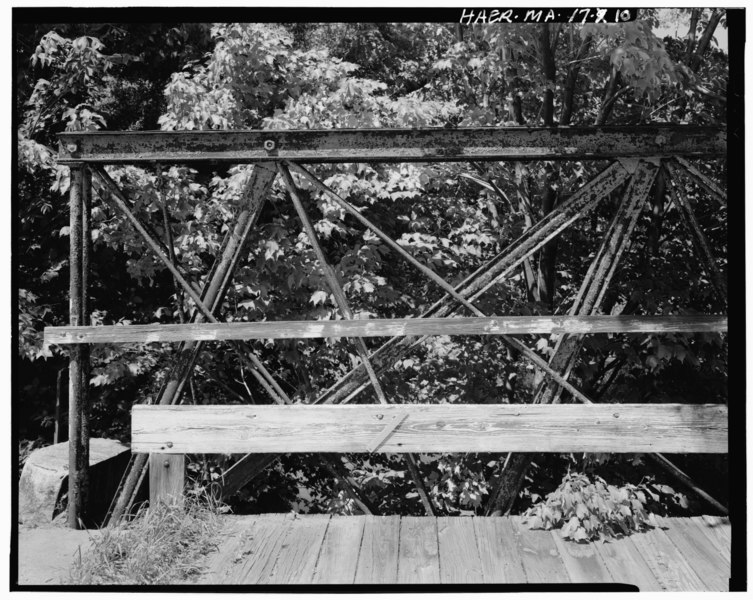File:End panels of north truss at west end, showing complex bracing configuration - Atherton Bridge, Spanning Nashua River on Bolton Road, Lancaster, Worcester County, MA HAER MASS,14-LANC.V,1-10.tif

Original file (5,000 × 3,982 pixels, file size: 18.99 MB, MIME type: image/tiff)
Captions
Captions
Summary[edit]
| End panels of north truss at west end, showing complex bracing configuration - Atherton Bridge, Spanning Nashua River on Bolton Road, Lancaster, Worcester County, MA | |||||
|---|---|---|---|---|---|
| Title |
End panels of north truss at west end, showing complex bracing configuration - Atherton Bridge, Spanning Nashua River on Bolton Road, Lancaster, Worcester County, MA |
||||
| Description |
J.H. Cofrode and Company; Phoenix Iron Company; Post, Simeon S; Wilder, Charles L; Thissle, Joshua; Thayer, Nathaniel; Hawley, Monica E, transmitter; Jackson, Donald C, transmitter; Massachusetts Department of Public Works, sponsor; Massachusetts Historical Commission, sponsor; Garvey, Jane F, sponsor; Turner, George R, sponsor; Roper, Stephen J, sponsor; Kapsch, Robert J, sponsor; Fitzgerald, Elsa, sponsor; Delony, Eric, project manager; Lowe, Jet, photographer; Stupich, Martin, photographer; Jackson, Donald C, historian; Hawley, Monica E, historian; Harshbarger, Patrick, historian; Schodek, Daniel L, delineator; Reese, Patricia, delineator; Kleinschmidt, Gary C, delineator; Payne, Chris, delineator; Fleisig, Morgan, delineator; Rowan, Mark C, delineator; Sosef, Rudolph, delineator; Bennett, Lola, historian; Healy, John, historian |
||||
| Depicted place | Massachusetts; Worcester County; Lancaster | ||||
| Date | Documentation compiled after 1968 | ||||
| Dimensions | 4 x 5 in. | ||||
| Current location |
Library of Congress Prints and Photographs Division Washington, D.C. 20540 USA http://hdl.loc.gov/loc.pnp/pp.print |
||||
| Accession number |
HAER MASS,14-LANC.V,1-10 |
||||
| Credit line |
|
||||
| Notes |
|
||||
| Source | https://www.loc.gov/pictures/item/ma1171.photos.077122p | ||||
| Permission (Reusing this file) |
|
||||
| Object location | 42° 27′ 20.02″ N, 71° 40′ 25″ W | View this and other nearby images on: OpenStreetMap |
|---|
File history
Click on a date/time to view the file as it appeared at that time.
| Date/Time | Thumbnail | Dimensions | User | Comment | |
|---|---|---|---|---|---|
| current | 18:24, 21 July 2014 |  | 5,000 × 3,982 (18.99 MB) | Fæ (talk | contribs) | GWToolset: Creating mediafile for Fæ. HABS 20 July 2014 (1401:1600) |
You cannot overwrite this file.
File usage on Commons
The following page uses this file:
Metadata
This file contains additional information such as Exif metadata which may have been added by the digital camera, scanner, or software program used to create or digitize it. If the file has been modified from its original state, some details such as the timestamp may not fully reflect those of the original file. The timestamp is only as accurate as the clock in the camera, and it may be completely wrong.
| Author | Library of Congress |
|---|---|
| Width | 5,000 px |
| Height | 3,982 px |
| Compression scheme | Uncompressed |
| Pixel composition | Black and white (Black is 0) |
| Orientation | Normal |
| Number of components | 1 |
| Number of rows per strip | 13 |
| Horizontal resolution | 1,000 dpi |
| Vertical resolution | 1,000 dpi |
| Data arrangement | chunky format |
| File change date and time | 01:49, 23 July 1998 |

